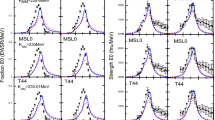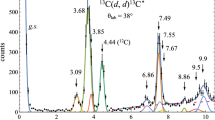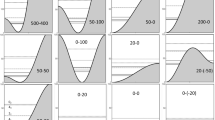Abstract
The proxy-SU(3) symmetry has been proposed for spin-orbit like nuclear shells using the asymptotic deformed oscillator basis for the single particle orbitals, in which the restoration of the symmetry of the harmonic oscillator shells is achieved by a change of the number of quanta in the z-direction by one unit for the intruder parity orbitals. The same definition suffices within the cartesian basis of the Elliott SU(3) model. Through a mapping of the cartesian Elliott basis onto the spherical shell model basis, we translate the proxy-SU(3) approximation into spherical coordinates, proving, that in the spherical shell model basis the proxy-SU(3) approximation corresponds to the replacement of the intruder parity orbitals by their de Shalit–Goldhaber partners. Furthermore it is shown, that the proxy-SU(3) approximation in the cartesian Elliott basis is equivalent to a unitary transformation in the z-coordinate, leaving the x–y plane intact, a result which in the asymptotic deformed oscillator coordinates implies, that the z-projections of angular momenta and spin remain unchanged. The present work offers a microscopic justification of the proxy-SU(3) approximation and in addition paves the way, for taking advantage of the proxy-SU(3) symmetry in shell model calculations.

Similar content being viewed by others
Data Availability Statement
This manuscript has no associated data or the data will not be deposited. [Authors’ comment: The data will be provided from the corresponding author upon request.]
References
F. Iachello, A. Arima, The Interacting Boson Model (Cambridge University Press, Cambridge, 1987)
F. Iachello, P. Van Isacker, The Interacting Boson-Fermion Model (Cambridge University Press, Cambridge, 1991)
A. Frank, P. Van Isacker, Symmetry Methods in Molecules and Nuclei (S y G editores, México, 2005)
G. Rosensteel, D.J. Rowe, Ann. Phys. (NY) 126, 343 (1980)
D.J. Rowe, J.L. Wood, Fundamentals of Nuclear Models: Foundational Models (World Scientific, Singapore, 2010)
V.K.B. Kota, SU(3) Symmetry in Atomic Nuclei (Springer, Singapore, 2020)
K.D. Launey, J.P. Draayer, T. Dytrych, G.-H. Sun, S.-H. Dong, Int. J. Mod. Phys. E 24, 1530005 (2015)
K.D. Launey, T. Dytrych, J.P. Draayer, Prog. Part. Nucl. Phys. 95, 044312 (2017)
M.G. Mayer, Phys. Rev. 74, 235 (1948)
M.G. Mayer, J.H.D. Jensen, Elementary Theory of Nuclear Shell Structure (Wiley, New York, 1955)
J.P. Elliott, Proc. R. Soc. Lond. Ser. A 245, 128 (1958)
J.P. Elliott, Proc. R. Soc. Lond. Ser. A 245, 562 (1958)
J.P. Elliott, M. Harvey, Proc. R. Soc. Lond. Ser. A 272, 557 (1963)
B.G. Wybourne, Classical Groups for Physicists (Wiley, New York, 1974)
M. Moshinsky, YuF Smirnov, The Harmonic Oscillator in Modern Physics (Harwood, Amsterdam, 1996)
F. Iachello, Lie Algebras and Applications (Springer, Berlin, 2006)
D. Bonatsos, A. Klein, Ann. Phys. (NY) 169, 61 (1986)
D. Bonatsos, I.E. Assimakis, N. Minkov, A. Martinou, R.B. Cakirli, R.F. Casten, K. Blaum, Phys. Rev. C 95, 064325 (2017)
D. Bonatsos, I.E. Assimakis, N. Minkov, A. Martinou, S. Sarantopoulou, R.B. Cakirli, R.F. Casten, K. Blaum, Phys. Rev. C 95, 064326 (2017)
A. Bohr, B.R. Mottelson, Nuclear Structure Vol. II: Nuclear Deformations (Benjamin, New York, 1975)
I. Hamamoto, B. Mottelson, Scholarpedia 7(4), 10693 (2012)
J. Jolie, A. Linnemann, Phys. Rev. C 68, 031301(R) (2003)
D. Bonatsos, Eur. Phys. J. A 53, 148 (2017)
S.G. Nilsson, Mat. Fys. Medd. K. Dan. Vidensk. Selsk. 29, 16 (1955)
S.G. Nilsson, I. Ragnarsson, Shapes and Shells in Nuclear Structure (Cambridge University Press, Cambridge, 1995)
R.B. Cakirli, K. Blaum, R.F. Casten, Phys. Rev. C 82, 061304 (2010)
D. Bonatsos, S. Karampagia, R.B. Cakirli, R.F. Casten, K. Blaum, L. Amon Susam, Phys. Rev. C 88, 054309 (2013)
R.M. Asherova, YuF Smirnov, V.N. Tolstoy, A.P. Shustov, Nucl. Phys. A 355, 25 (1981)
D. Bonatsos, C. Daskaloyannis, P. Kolokotronis, D. Lenis (1994). arXiv: hep-th/9411218
K.T. Hecht, A. Adler, Nucl. Phys. A 137, 129 (1969)
A. Arima, M. Harvey, K. Shimizu, Phys. Lett. B 30, 517 (1969)
R.D. Ratna Raju, J.P. Draayer, K.T. Hecht, Nucl. Phys. A 202, 433 (1973)
J.P. Draayer, K.J. Weeks, K.T. Hecht, Nucl. Phys. A 381, 1 (1982)
J.P. Draayer, K.J. Weeks, Phys. Rev. Lett. 51, 1422 (1983)
J.P. Draayer, K.J. Weeks, Ann. Phys. (N.Y.) 156, 41 (1984)
J.P. Draayer, in Algebraic Approaches to Nuclear Structure, ed. by R.F. Casten (Harwood, Chur, 1993), p. 423
J.N. Ginocchio, Phys. Rev. Lett. 78, 436 (1997)
J.N. Ginocchio, J. Phys. G: Nucl. Part. Phys. 25, 617 (1999)
A.P. Zuker, J. Retamosa, A. Poves, E. Caurier, Phys. Rev. C 52, R1741 (1995)
A.P. Zuker, A. Poves, F. Nowacki, S.M. Lenzi, Phys. Rev. C 92, 024320 (2015)
O. Castaños, M. Moshinsky, C. Quesne, Group Theory and Special Symmetries in Nuclear Physics Ann Arbor, 1991, edited by J. P. Draayer and J. Jänecke (World Scientific, Singapope, 1992) p. 80
O. Castaños, M. Moshinsky, C. Quesne, Phys. Lett. B 277, 238 (1992)
O. Castaños, V. Velázquez A, P.O. Hess, J.G. Hirsch, Phys. Lett. B 321, 303 (1994)
A. de Shalit, M. Goldhaber, Phys. Rev. 92, 1211 (1953)
C. Cohen-Tannoudji, B. Diu, F. Laloë, Quantum Mechanics (Hermann, Paris, 1977), complement B\(_{\rm VII}\) (1977)
K.T.R. Davies, S.J. Krieger, Can. J. Phys. 69, 62 (1991)
R.R. Chasman, S. Wahlborn, Nucl. Phys. A 90, 401 (1967)
E. Chacón, M. de Llano, Rev. Mex. Fís. 12, 57 (1963)
A. Martinou, N. Minkov, S. Sarantopoulou, S. Peroulis, I.E. Assimakis, D. Bonatsos, Bulg. J. Phys. 46, 337 (2019)
P. Federman, S. Pittel, Phys. Lett. B 69, 385 (1977)
P. Federman, S. Pittel, Phys. Lett. B 77, 29 (1978)
P. Federman, S. Pittel, Phys. Rev. C 20, 820 (1979)
R.F. Casten, Nucl. Phys. A 443, 1 (1985)
R.F. Casten, Nuclear Structure from a Simple Perspective (Oxford University Press, Oxford, 2000)
J.P. Draayer, Y. Leschber, S.C. Park, R. Lopez, Comp. Phys. Commun. 56, 279 (1989)
A. Martinou, D. Bonatsos, Nuclear Structure Physics, edited by A Shukla (CRC Press, Taylor and Francis Group, Boca Raton, 2020). in press
A. Martinou, D. Bonatsos, N. Minkov, I.E. Assimakis, S. Sarantopoulou, S. Peroulis, in Proceedings of the International Workshop on Nuclear Theory (Rila 2018) 37, edited by M. Gaidarov and N. Minkov (Heron, Sofia, 2018) 41 (2018)
J.P. Elliott, C.E. Wilsdon, Proc. R. Soc. Lond. Ser. A 302, 509 (1968)
O. Sorlin, M.-G. Porquet, Prog. Part. Nucl. Phys. 61, 602 (2008)
P.R. Halmos, G. Lumer, J.J. Schäffer, Proc. Am. Math. Soc. 4, 142 (1953)
P.R. Halmos, G. Lumer, Proc. Am. Math. Soc. 5, 589 (1954)
S.J. Bernau, J. Austr. Math. Soc. 8, 17 (1968)
Z. Sebestyén, Zs Tarcsay. Period. Math. Hung. 75, 268 (2017)
J. Cseh, Phys. Rev. C 101, 054306 (2020)
D. Bonatsos, A. Martinou, S. Sarantopoulou, I.E. Assimakis, S. Peroulis, N. Minkov, Eur. Phys. J. Spec. Top. https://doi.org/10.1140/epjst/e2020-000034-3 (2020)
Author information
Authors and Affiliations
Corresponding author
Additional information
Communicated by Nicolas Alamanos.
Financial support by the Greek State Scholarships Foundation (IKY) and the European Union within the MIS 5033021 action, by the Bulgarian National Science Fund (BNSF) under Contract No. KP-06-N28/6 and by National Research, Development and Innovation Fund of Hungary, under the K18 funding scheme with Project No. K 128729 is gratefully acknowledged.
Appendices
Appendix A: Prerequisites for the unitarity of the operators
Within the pseudo-SU(3) approach it is well known, that there is a unitary transformation connecting the normal parity orbitals in a nuclear shell to their pseudo-SU(3) counterparts. A pedagogical description of this unitary transformation is given in [41], applied to the case of the one-dimensional harmonic oscillator (1D-HO) (Sect. 4 of [41]). Subsequently, the unitary transformation for the three-dimensional harmonic oscillator (3D-HO) from spherical coordinates to the pseudo-SU(3) basis is given in Sect. 5 of [41], while the unitary transformation, appropriate for the spherical Nilsson Hamiltonian (with deformation \(\epsilon =0\)), which includes a spin-orbit interaction term and an \(\mathbf {l}^2\) term, where \(\mathbf {l}\) is orbital angular momentum, is given in Sect. 6 of [41]. A concise version of this work is given in [42]. A generalization of this unitary transformation to the case of the deformed Nilsson Hamiltonian has been given in [43].
Let us consider an operator \(G(\mathbf {r}, \mathbf {p}, \mathbf {S})\), where \(\mathbf {r}\), \(\mathbf {p}\), \(\mathbf {S}\) are the position, momentum, and spin respectively. The operator G will not be in general unitary, but it can be made unitary through the use of the Hermitian operator [41]
by taking
Since \(\mathcal {O}\) is a Hermitian operator, it is possible, to find a basis, in which this operator is diagonal. In this basis the operator \([\mathcal {O} (\mathbf {r}, \mathbf {p}, \mathbf {S})]^{-1/2}\) can be obtained by taking the square roots of the inverse terms in the diagonal, provided that the eigenvalues of \(\mathcal {O}\) are positive. Square roots of positive operators have been considered repeatedly in the mathematical literature [60,61,62,63].
In the case of the original 1D-HO Hamiltonian one has [45]:
where x and p are the coordinate and the corresponding momentum, while \(a^\dagger \) and a denote the usual creation and annihilation operators. The unitary operator is obtained from the usual annihilation operator a and has the form [41]
It is clear, that the above mentioned prerequisites are fulfilled, since the operator \(a^\dagger a\) in the basis considered is diagonal and has positive eigenvalues, so that the square roots of their inverses can be calculated. The Hamiltonian resulting from the unitary transformation is [41]
This implies, that the levels characterized by \(\mathcal {N}\) quanta in the old Hamiltonian carry \(\mathcal {N}-1\) quanta in the new one, sharing the same energy, while the ground state of the old Hamiltonian has no counterpart. In other words, in the new Hamiltonian \(\mathcal {N}\) is replaced by \(\mathcal {N}-1\), but the loss of energy is counterbalanced by the \(+1\) term appearing in Eq. (61). This \(+1\) term plays a major role in the proxy-SU(3) approximation, as discussed in Sect. 7.
In the above the spectra of the old and the new Hamiltonian are the same, as they should be for a unitary transformation. It should also be noticed, that we have the complete set of states of the harmonic oscillator both before and after the unitary transformation, i.e., the ground state is included in both cases. Therefore the U(1) symmetry characterizing the 1D-HO before the unitary transformation is conserved after the unitary transformation.
Appendix B: Unitary transformations in the pseudo-SU(3) scheme
For the sake of comparison, the original 3D-HO Hamiltonian for a particle with spin 1/2 is:
where \(\mathbf{r}\) and \(\mathbf{p}\) are the coordinates and the corresponding momenta, while \(\mathbf {a^\dagger }\) and \(\mathbf{a}\) denote the usual creation and annihilation operators. The unitary operator is obtained from \((\mathbf{a} \cdot \mathbf{S})\), where \(\mathbf{S}\) is the spin operator, and reads [41]
The Hamiltonian resulting from the unitary transformation is [41]:
This again implies, that the levels characterized by \(\mathcal {N}\) quanta in the old Hamiltonian carry \(\mathcal {N}-1\) quanta in the new one, sharing the same energy, while the ground state of the old Hamiltonian has no counterpart. As in the case of the 1D-HO, the loss of one quantum of excitation energy by the fact that \(\mathcal {N}\) of the original Hamiltonian is mapped onto \(\mathcal {N}-1\) in the final Hamiltonian is counterbalanced by the \(+1\) term in Eq. (64). This \(+1\) term plays a major role in the proxy-SU(3) approximation, as discussed in Sect. 7. The unitary transformation considered above is quite general, since it involves the spin and the orbital angular momentum.
Rights and permissions
About this article
Cite this article
Martinou, A., Bonatsos, D., Minkov, N. et al. Proxy-SU(3) symmetry in the shell model basis. Eur. Phys. J. A 56, 239 (2020). https://doi.org/10.1140/epja/s10050-020-00239-0
Received:
Accepted:
Published:
DOI: https://doi.org/10.1140/epja/s10050-020-00239-0




